sensor Lancia Delta 2013 Owner handbook (in English)
[x] Cancel search | Manufacturer: LANCIA, Model Year: 2013, Model line: Delta, Model: Lancia Delta 2013Pages: 295, PDF Size: 8.29 MB
Page 144 of 295

142KNOWING YOUR CAR
If the driver carries out a voluntary or involuntary action
on the steering during the parking manoeuvre (touch-
ing it or preventing its movement), the manoeuvre will
be interrupted.
If the road surface is very uneven or there are obstacles
under the wheels affecting the movement of the vehicle,
preventing it from continuing along the correct trajectory,
the manoeuvre may be interrupted.
Manoeuvre end
If the size of parking space permits, the parking ma-
noeuvre may be performed in one go; when reverse gear
is released the wheels will be realigned and the manoeu-
vre will be considered completed; the system will conse-
quently be deactivated. If the size of the parking space is
smaller, it may take several manoeuvres, the driver will
be advised to complete the parking manoeuvre manually
via a dedicated messages in the instrument panel display.General warnings
❍The ultimate responsibility when parking, however,
always rests with the driver. During these manoeuvres,
always make sure that no people, animals or objects are
within the manoeuvring area. The Magic Parking sys-
tem (like parking sensors) is designed to assist drivers: in
all cases, you must always pay the utmost attention dur-
ing potentially dangerous manoeuvres, even when these
are carried out a low speed:
❍If the sensors undergo shocks influencing their posi-
tion, the system operation could be strongly degraded.
❍If the sensors are dirty, covered by snow, ice or mud
or are repainted compared to the original conditions, the
system operation could be strongly degraded.
❍It is extremely important, for the correct operation of
the system, that the sensors are always kept clean. Dur-
ing cleaning make sure not to scratch or damage them;
avoid using dry or rough cloths. The sensors should be
washed using clean water with the addition of car sham-
poo if necessary. When using special washing equipment
such as high pressure jets or steam cleaning, clean the
sensors very quickly keeping the jet more than 10 cm
away.
If you wish to stop the steering wheel with
your hands during a manoeuvre, it is
advisable to handle it firmly on the outer
rim. Do not try and keep your hands on the inside
or hold the spokes.
Page 145 of 295
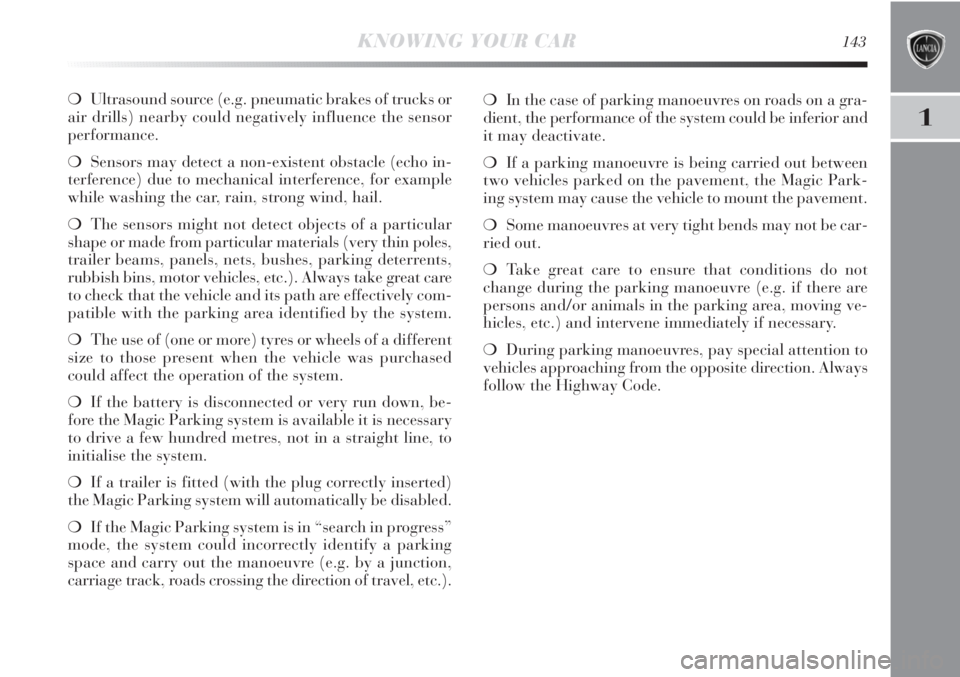
1
KNOWING YOUR CAR143
❍Ultrasound source (e.g. pneumatic brakes of trucks or
air drills) nearby could negatively influence the sensor
performance.
❍Sensors may detect a non-existent obstacle (echo in-
terference) due to mechanical interference, for example
while washing the car, rain, strong wind, hail.
❍The sensors might not detect objects of a particular
shape or made from particular materials (very thin poles,
trailer beams, panels, nets, bushes, parking deterrents,
rubbish bins, motor vehicles, etc.). Always take great care
to check that the vehicle and its path are effectively com-
patible with the parking area identified by the system.
❍The use of (one or more) tyres or wheels of a different
size to those present when the vehicle was purchased
could affect the operation of the system.
❍If the battery is disconnected or very run down, be-
fore the Magic Parking system is available it is necessary
to drive a few hundred metres, not in a straight line, to
initialise the system.
❍If a trailer is fitted (with the plug correctly inserted)
the Magic Parking system will automatically be disabled.
❍If the Magic Parking system is in “search in progress”
mode, the system could incorrectly identify a parking
space and carry out the manoeuvre (e.g. by a junction,
carriage track, roads crossing the direction of travel, etc.).❍In the case of parking manoeuvres on roads on a gra-
dient, the performance of the system could be inferior and
it may deactivate.
❍If a parking manoeuvre is being carried out between
two vehicles parked on the pavement, the Magic Park-
ing system may cause the vehicle to mount the pavement.
❍Some manoeuvres at very tight bends may not be car-
ried out.
❍Take great care to ensure that conditions do not
change during the parking manoeuvre (e.g. if there are
persons and/or animals in the parking area, moving ve-
hicles, etc.) and intervene immediately if necessary.
❍During parking manoeuvres, pay special attention to
vehicles approaching from the opposite direction. Always
follow the Highway Code.
Page 147 of 295
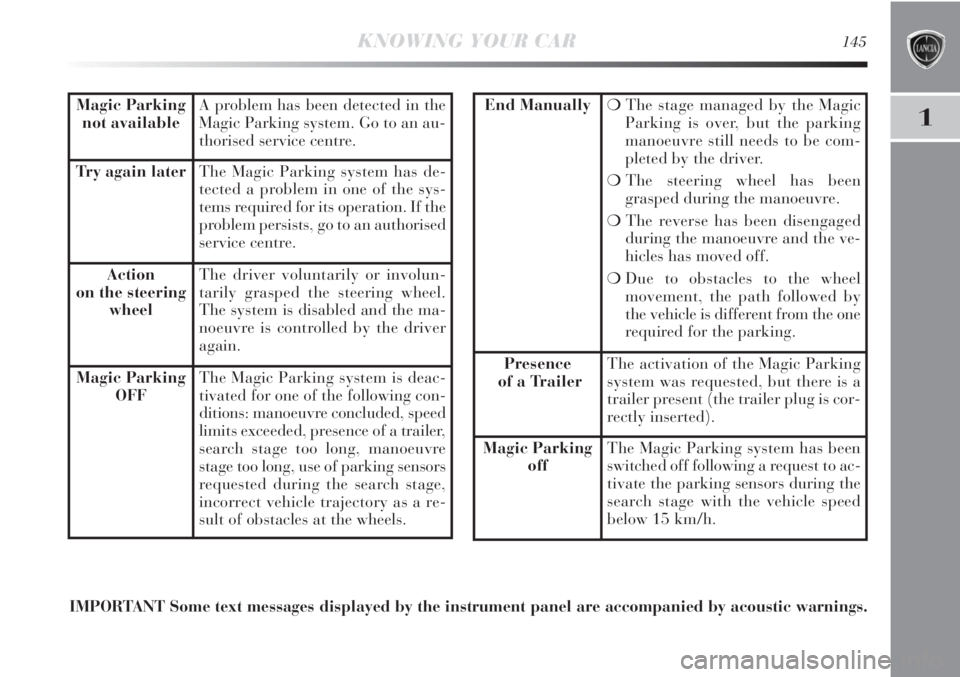
1
KNOWING YOUR CAR145
Magic Parking
not availableA problem has been detected in the
Magic Parking system. Go to an au-
thorised service centre.
Try again laterThe Magic Parking system has de-
tected a problem in one of the sys-
tems required for its operation. If the
problem persists, go to an authorised
service centre.
Action
on the steering
wheelThe driver voluntarily or involun-
tarily grasped the steering wheel.
The system is disabled and the ma-
noeuvre is controlled by the driver
again.
Magic Parking
OFFThe Magic Parking system is deac-
tivated for one of the following con-
ditions: manoeuvre concluded, speed
limits exceeded, presence of a trailer,
search stage too long, manoeuvre
stage too long, use of parking sensors
requested during the search stage,
incorrect vehicle trajectory as a re-
sult of obstacles at the wheels.
End Manually❍The stage managed by the Magic
Parking is over, but the parking
manoeuvre still needs to be com-
pleted by the driver.
❍The steering wheel has been
grasped during the manoeuvre.
❍The reverse has been disengaged
during the manoeuvre and the ve-
hicles has moved off.
❍Due to obstacles to the wheel
movement, the path followed by
the vehicle is different from the one
required for the parking.
Presence
of a TrailerThe activation of the Magic Parking
system was requested, but there is a
trailer present (the trailer plug is cor-
rectly inserted).
Magic Parking
offThe Magic Parking system has been
switched off following a request to ac-
tivate the parking sensors during the
search stage with the vehicle speed
below 15 km/h.
IMPORTANT Some text messages displayed by the instrument panel are accompanied by acoustic warnings.
Page 148 of 295

146KNOWING YOUR CAR
FRONT AND REAR PARKING SENSORS
(combined with Magic Parking)
(for versions/markets where provided)
The parking sensors provide the driver with distance in-
formation when approaching obstacles in front of and be-
hind the vehicle (versions with 4 front and 4 rear sensors)
always combined with the Magic Parking function. The
system therefore provides a further aid during parking
manoeuvres because it allows the identification of obsta-
cles outside of the driver’s field of vision. The driver is notified of the presence and distance of the
obstacle from the vehicle by an acoustic signal which
varies depending on the distance from the obstacle (as the
distance from the obstacle decreases the frequency of the
acoustic signal increases).
SENSORS
In order to measure the distance of obstacles, the system
uses 4 sensors located in the front bumper (where pro-
vided) fig. 85 and 4 sensors located in the rear bumper
fig. 86.
fig. 85L0E0059mfig. 86L0E0298m
Page 149 of 295

1
KNOWING YOUR CAR147
Version with 8 sensors
On the version with 4 front sensors and 4 rear sensors,
the system is activated when reverse gear is engaged or
by pressing the button fig. 87. If there has been a request
to activate the Magic Parking function, the front and rear
sensors are not automatically activated during the search
for a parking space, but can be activated by pressing the
special button (fig. 87) or by engaging reverse gear when
the speed is below around 15 km/h.
When reverse gear is released, the front and rear sensors
remain activated until a speed of around 15 km/h is ex-
ceeded to allow the parking manoeuvre to be completed.
The system can also be activated by pressing the button
fig. 87 in the central panel: a warning light in the but-
ton comes on when the system is activated.The sensors are deactivated by pressing the button again
fig. 87 or when a speed of 15 km/h is exceeded: the
warning light in the button is off when the system is not
active.
When the sensors are activated, the system starts to pro-
duce acoustic signals from the front or rear buzzers as
soon as an obstacle is detected with the frequency in-
creasing as the obstacle gets closer.
When the obstacle is less than about 30 cm away, the
sound becomes continuous. Depending on the position of
the obstacle (in front or behind) the sound is produced
by the corresponding buzzers (front or rear). The obsta-
cle closest to the vehicle is signalled.
The acoustic signal stops immediately if the distance of
the obstacle increases. The sound cycle remains constant
if the distance measured by the centre sensors remains
unchanged, whilst if this situation occurs for the side sen-
sors, the signal is interrupted after about 3 seconds (for
example, to prevent signals in the case of manoeuvres
alongside walls).
fig. 87L0E0249m
The responsibility for parking and other
dangerous manoeuvres always and in every
case lies with the driver. While manoeu-
vring, always make sure that no-one is in the area
concerned (especially children) or animals. The
parking sensors are designed to assist drivers: in
any case, you must always pay the utmost atten-
tion during potentially dangerous manoeuvres,
even when carried out at low speed.
Page 150 of 295

148KNOWING YOUR CAR
ACOUSTIC SIGNAL
The information concerning the presence and distance of
an obstacle from the vehicle is transmitted by means of
acoustic signals from 2 buzzers installed in the passenger
compartment:
❍a front buzzer warns of the presence of obstacles at
the front and a buzzer located at the rear warns of the
presence of obstacles at the rear. This notifies the driver
of the direction (front/rear) of the obstacles.
Operation is automatically activated when reverse gear
is engaged.
The acoustic signal:
❍increases as the distance between the car and the ob-
stacle decreases;
❍becomes continuous when the distance between the
car and the obstacle is less than around 30 cm and stops
immediately if the distance increases;
❍is constant if the distance is unvaried; if this situa-
tion occurs for the side sensors, the indication will stop
after about 3 seconds to avoid, for example, warning in-
dications in the event of manoeuvres alongside walls.The sensor must be clean of mud, dirt, snow
or ice in order for the system to operate cor-
rectly. Be careful not to scratch or damage the
sensors while cleaning them. Avoid using dry, rough
or hard cloths. The sensors should be washed using
clean water with the addition of car shampoo if nec-
essary. When using special washing equipment such
as high pressure jets or steam cleaning, clean the
sensors very quickly keeping the jet more than
10 cm away.
Only have the bumpers repainted or any re-
touches to the paintwork in the area of the
sensors carried out by a Lancia Dealership.
If the paint is incorrectly applied this could ad-
versely affect the operation of the parking sensors.
SENSOR OPERATING RANGE
The sensors allow the system to check the front part (ver-
sion with 8 sensors) and rear part of the vehicle.
Their position covers the middle and side areas of the
front and rear of the vehicle. If an obstacle is located in
a middle area, it is detected when the distance is less than
about 0.9 m (front) and 1.30 m (rear).
If the obstacle is located at the side, it is detected at dis-
tances of less than 0.6 m.
Page 151 of 295
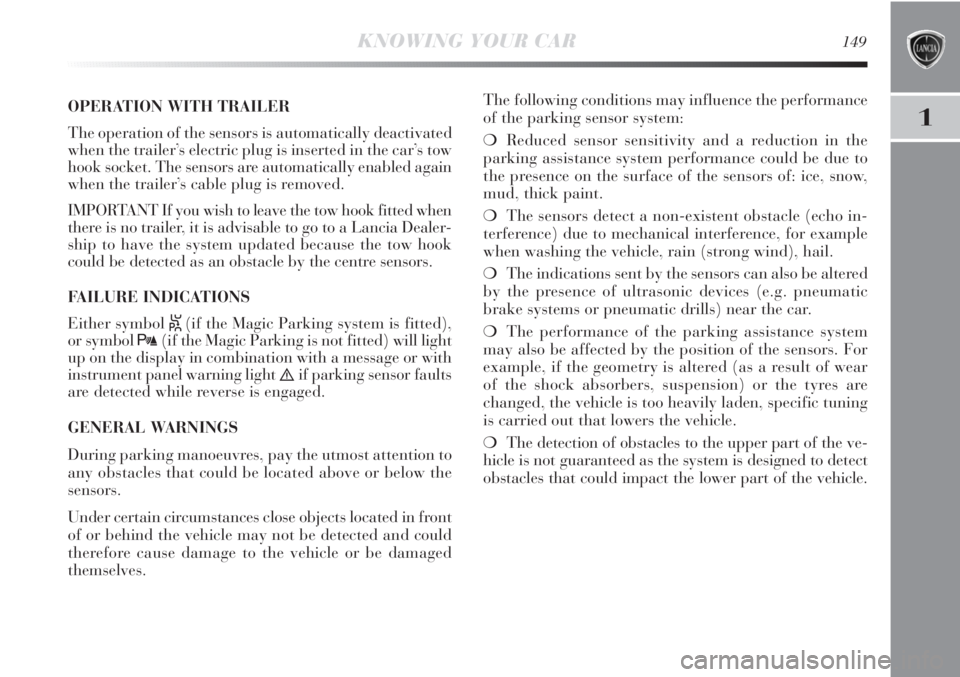
1
KNOWING YOUR CAR149
OPERATION WITH TRAILER
The operation of the sensors is automatically deactivated
when the trailer’s electric plug is inserted in the car’s tow
hook socket. The sensors are automatically enabled again
when the trailer’s cable plug is removed.
IMPORTANT If you wish to leave the tow hook fitted when
there is no trailer, it is advisable to go to a Lancia Dealer-
ship to have the system updated because the tow hook
could be detected as an obstacle by the centre sensors.
FAILURE INDICATIONS
Either symbol
S(if the Magic Parking system is fitted),
or symbol
t(if the Magic Parking is not fitted) will light
up on the display in combination with a message or with
instrument panel warning light
èif parking sensor faults
are detected while reverse is engaged.
GENERAL WARNINGS
During parking manoeuvres, pay the utmost attention to
any obstacles that could be located above or below the
sensors.
Under certain circumstances close objects located in front
of or behind the vehicle may not be detected and could
therefore cause damage to the vehicle or be damaged
themselves.The following conditions may influence the performance
of the parking sensor system:
❍Reduced sensor sensitivity and a reduction in the
parking assistance system performance could be due to
the presence on the surface of the sensors of: ice, snow,
mud, thick paint.
❍The sensors detect a non-existent obstacle (echo in-
terference) due to mechanical interference, for example
when washing the vehicle, rain (strong wind), hail.
❍The indications sent by the sensors can also be altered
by the presence of ultrasonic devices (e.g. pneumatic
brake systems or pneumatic drills) near the car.
❍The performance of the parking assistance system
may also be affected by the position of the sensors. For
example, if the geometry is altered (as a result of wear
of the shock absorbers, suspension) or the tyres are
changed, the vehicle is too heavily laden, specific tuning
is carried out that lowers the vehicle.
❍The detection of obstacles to the upper part of the ve-
hicle is not guaranteed as the system is designed to detect
obstacles that could impact the lower part of the vehicle.
Page 156 of 295
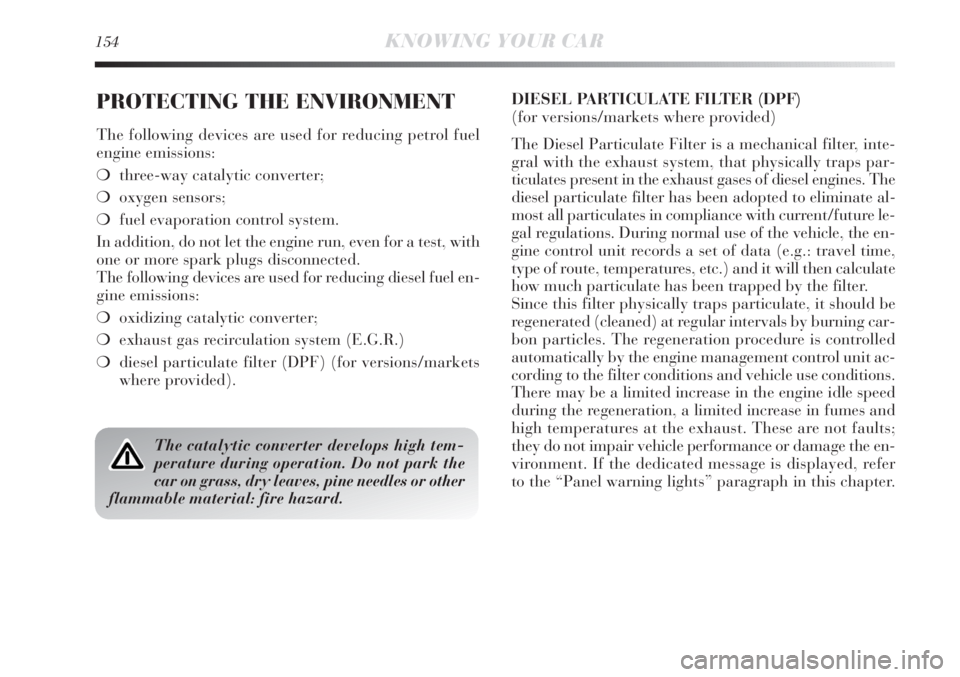
154KNOWING YOUR CAR
PROTECTING THE ENVIRONMENT
The following devices are used for reducing petrol fuel
engine emissions:
❍three-way catalytic converter;
❍oxygen sensors;
❍fuel evaporation control system.
In addition, do not let the engine run, even for a test, with
one or more spark plugs disconnected.
The following devices are used for reducing diesel fuel en-
gine emissions:
❍oxidizing catalytic converter;
❍exhaust gas recirculation system (E.G.R.)
❍diesel particulate filter (DPF) (for versions/markets
where provided).DIESEL PARTICULATE FILTER (DPF)
(for versions/markets where provided)
The Diesel Particulate Filter is a mechanical filter, inte-
gral with the exhaust system, that physically traps par-
ticulates present in the exhaust gases of diesel engines. The
diesel particulate filter has been adopted to eliminate al-
most all particulates in compliance with current/future le-
gal regulations. During normal use of the vehicle, the en-
gine control unit records a set of data (e.g.: travel time,
type of route, temperatures, etc.) and it will then calculate
how much particulate has been trapped by the filter.
Since this filter physically traps particulate, it should be
regenerated (cleaned) at regular intervals by burning car-
bon particles. The regeneration procedure is controlled
automatically by the engine management control unit ac-
cording to the filter conditions and vehicle use conditions.
There may be a limited increase in the engine idle speed
during the regeneration, a limited increase in fumes and
high temperatures at the exhaust. These are not faults;
they do not impair vehicle performance or damage the en-
vironment. If the dedicated message is displayed, refer
to the “Panel warning lights” paragraph in this chapter.
The catalytic converter develops high tem-
perature during operation. Do not park the
car on grass, dry leaves, pine needles or other
flammable material: fire hazard.
Page 225 of 295

IN AN EMERGENCY223
4
FUSE SUMMARY TABLE
F12
F12
F13
F13
F31
F33
F34
F35
F36
F37
F38
F39
F40
F417.5
15
7.5
15
5
20
20
5
20
7.5
10
10
30
7.538
38
38
38
38
38
38
38
38
38
38
38
38
38
USERS FUSE AMPS FIGURE
Right dipped beam headlight
Right dipped beam headlight (Xenon gas discharge bulb)
Left dipped beam headlight, headlight alignment corrector
Left dipped beam headlight (Xenon gas discharge bulb)
Climate control system fan relay coil, body computer
Left rear window winder
Right rear window winder
Reversing lights, engine compartment junction unit relay coils,
brake light pedal control (normally closed contact),
water in diesel sensor, air flow meter/control on clutch pedal
and brake servo pressure sensor (1.4 Turbo Multi Air versions)
Central locking system control unit, fuel flap,
dead lock, tailgate release
Third brake light, instrument panel, Adaptive Headlights Node
(1.4 Turbo Multi Air versions excluded), control unit on left hand
gas discharge headlight (1.4 Turbo Multi Air versions excluded)
Front roof lights, rear central roof light, driver side and passenger side sun
visor lights, luggage compartment roof light, glove compartment courtesy
light (Platinum trim level with optional sun roof - excluding MultiAir version)
Radio wiring/Radio/Radio Navigator (excluding MultiAir versions),
Blue&Me
TMNode, alarm siren, alarm system on roof light, climate control
unit, tyre pressure monitoring system control unit, diagnosis socket connector,
rear roof lights, voltage stabiliser (MultiAir versions without optional HI-FI)
Heated rear window
Electric door mirror demisters, demisters on windscreen jets
Page 226 of 295
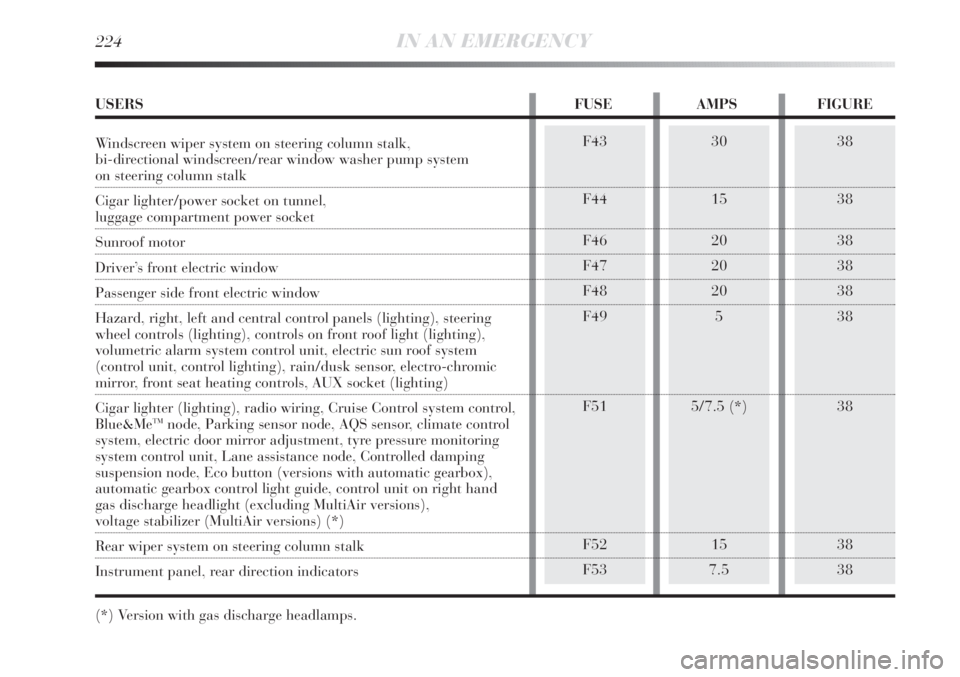
224IN AN EMERGENCY
38
38
38
38
38
38
38
38
38F43
F44
F46
F47
F48
F49
F51
F52
F5330
15
20
20
20
5
5/7.5 (*)
15
7.5
USERS FUSE AMPS FIGURE
Windscreen wiper system on steering column stalk,
bi-directional windscreen/rear window washer pump system
on steering column stalk
Cigar lighter/power socket on tunnel,
luggage compartment power socket
Sunroof motor
Driver’s front electric window
Passenger side front electric window
Hazard, right, left and central control panels (lighting), steering
wheel controls (lighting), controls on front roof light (lighting),
volumetric alarm system control unit, electric sun roof system
(control unit, control lighting), rain/dusk sensor, electro-chromic
mirror, front seat heating controls, AUX socket (lighting)
Cigar lighter (lighting), radio wiring, Cruise Control system control,
Blue&Me
TMnode, Parking sensor node, AQS sensor, climate control
system, electric door mirror adjustment, tyre pressure monitoring
system control unit, Lane assistance node, Controlled damping
suspension node, Eco button (versions with automatic gearbox),
automatic gearbox control light guide, control unit on right hand
gas discharge headlight (excluding MultiAir versions),
voltage stabilizer (MultiAir versions) (*)
Rear wiper system on steering column stalk
Instrument panel, rear direction indicators
(*) Version with gas discharge headlamps.